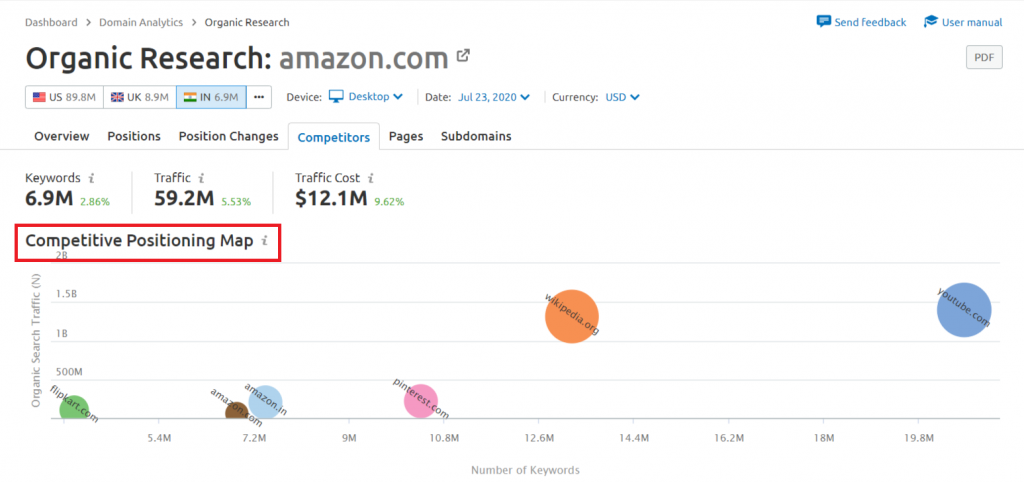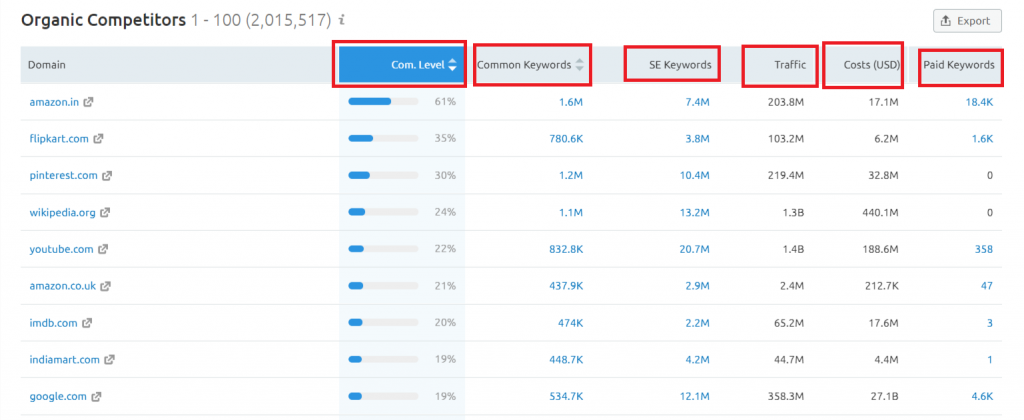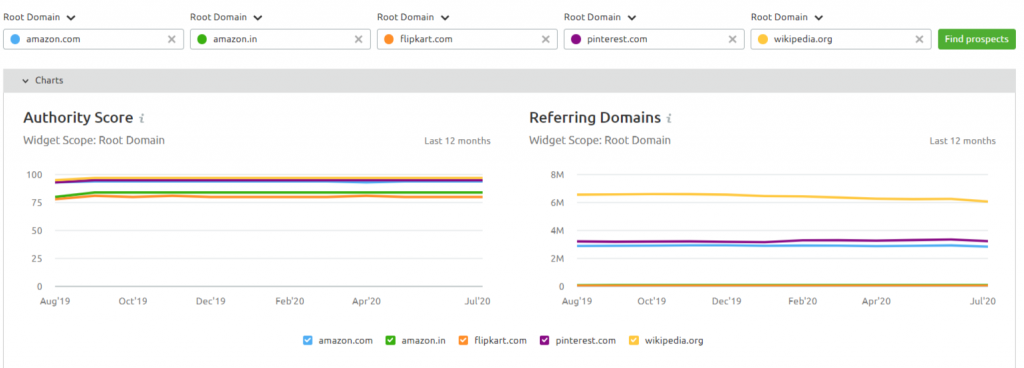How to Perform Competitor Research in an Hour with SEMrush

2 Min Read
Buy or bury the competition
Jack Welch
We agree for sure that the field of SEO is filled with surprises and constantly adapting to the changes in the SERP algorithms can feel overwhelming. And competition is another dimension of stress! But here’s what we have learned – SEO can be dealt with in a seemingly uncomplicated way if you have the right tactics on point and the tools which would give you the right direction of where to head to for success.
Ever felt the crunch in competitor research? Then, this article is just for you!
Here, we are going to be talking about the tool SEMrush and its usability for conducting a brilliantly adept competitive research report in a time-bound manner.
Note: SEMrush is a paid market intelligence tool that you can try here for free! Why are we vouching for it? Well, you’ll know it as you read further.
We have compared SEMrush with other industry tools like Ahrefs that offer a similar experience, though we find the former to be more efficient in terms of time, user experience, and labour as well. So let’s get right to the crux of the topic wherein we take you through the steps on how to pull a competitive research report from SEMrush in very less time – as little as an hour(depending on the size of your domain).
What are the key elements of competitor analysis in SEO?
- Identifying competition
- Looking up their overall SEO health
- Seeing their ranking keywords in organic search
- Analyzing their backlink profile with respect to both levels ie domain as well as any specific page in particular
Let’s go through and undertand each of these in a step-wise manner –
Step 1: Finding your Actual SEO Competitors
You think you are aware of your competitors, but there’s more to know when you explore the data. Of course, you can start without the use of tools by simply entering your top target keyword in Google, to see which domains are ranking. For more accuracy, you can do this for the next 10-20 keywords you are targeting, get the data onto a spreadsheet, and calculate which domains appear most frequently and in what position.
But everyone can agree that this is a tough and laborious task where you are likely to rank for thousands of keywords at a time(it’s a cakewalk if you rank only for a handful of them). This is where you can make use of market intelligence tools like SEMrush to make life easier! There is a wholesome Competitive Research toolkit available by them where you can examine for all online niches like paid search, organic search, social media, etc. However, in this article, we are looking closely at the organic search section of the toolkit.
To get started, we login to the dashboard and head to the Competitive Research toolkit, and select Organic Research. Enter your domain name in the search bar. Right after clicking search, you will get a display of the overall SEO health of your website. To know more in detail about your competition, click on Competitors.
The first thing you’ll notice is the Positioning Map of you and the top 5 of your competitors where you are positioned with the organic search traffic you have in a month vs the number of keywords you rank for. The farther and higher you are from the origin, the better your performance is. Right above that, you can have a glimpse at the number of keywords where your website is displayed in Google’s top 100 search results, your website’s monthly traffic, and the monthly traffic cost to rank on Google Ads.

As you scroll down, the next thing you’ll find is the list of all your competitors on Google. They are presented with their domain name, the common keywords, the total number of organic and paid keywords with the cost, the organic traffic it receives in a month. Pay attention to the commonality level which takes into account all the factors beside and gives an aggregate percentage of the similarity between you and your competition.

The more common keywords you rank for with them, the more you are competing with them for the position.
In this way, you get a bird’s eye view of your top competitors who you need to outperform.
Step 2: Looking up their Overall SEO Health
Before going into specifics, you might want to get an overview of your competitions SEO success. This will serve as a base for your SEO efforts, you will have a clear idea with respect to what aspect of SEO do they outrank you and therefore which part you need to focus on.
You simply can view this, by clicking the domain names that appear in the competitors list (they are clickable). You will be taken to the Domain Analysis section of the SEO toolkit. Here, you can view the overall performance of their website. Some of the key elements you need to check are their organic ranking, the number of keywords for which they are ranking, backlink profile, etc.
Step 3: Keyword Analysis of your Competitors
Keywords are one of the important things to analyze in competitor research. And more specifically, the keyword gaps. What are keyword gaps? These are the keywords that your competitors are targeting and you aren’t. By identifying the keywords your competition is using on their pages, you can also get an idea of the particular topics they are covering and you aren’t, thereby obtaining content ideas as well.
If you’re doing it with SEMrush, you just need to head to the Keyword Gap section right below the Organic Research section. You can enter 5 of your competing domains at a time and click on the Go button which would take you to a display of list that has up to 10,000 keywords that your competitors use to drive traffic to their website. This report would also give you data on search volume, keyword difficulty, and cost-per-click estimates. You can filter and observe it the way you wish; our personal preference is to view the keywords for which the competitors are ranking in the top 20.

The first 2 widgets show you the top keyword opportunities and the overlap of keywords between competing domains as a visual glimpse, but you get a comprehensive report below where you can filter the data according to your requirement and select the one which you would like to target. Simply check the box next to it and export them to a .csv file or a spreadsheet. You can also export it to the Keyword Manager where you can collectively manage different keywords via lists.

Once you have those keywords that you need to work on, the next step is to group them according to a suitable niche such as specific product or service, geography or subject matter categories. Once they are organized, you’ll have a list of topics in hand that you can create new content for, or repurpose your old content with those related keywords to drive in organic search traffic.
Step 4: Analyzing their Backlink Profile
Of course, as far as rankings are concerned, backlink profile analysis is the next sensible step in competitor analysis.
In competitor research, you might want to find data for two types of competitors ie topic and domain competitors. Topic competitors are the pages and websites that are ranking for the keywords you are interested in and domains are those that come up in a search engine for the keywords that your entire domain is targeting for. The importance of link building is well understood by competing websites and that’s why they acquire backlinks from niche websites. The ones who partner with them might gladly provide you with one as well. So how do we go about doing it?
SEMrush has the Backlink Gap tool wherein you can compare and evaluate the backlink profile of your competitors with that of yours. Just like the Keyword gap tool, you just need to add the domain names of 4 of your competitors with yours and click on ‘Find Prospects’. The report covers every aspect of their backlink profile and gives you a graphical representation of the authority score and the referring domains in the last 12 months.

You can view the gaps of each of these domains in the report below, which is clickable and it takes you to the Backlink Analytics section of the Link Building. And similar to the Keyword Gap tool, you can export it or add it to a project or create a new one as well.

Competitors can be added up to the URL level in both the Backlink as well as the Keyword gap tool. And also, you can compare flexibly interchanging between domains, sub-domains, and URL levels.
So, basically …
This concludes the article on how your competitor research should look like with reduced labour and the most efficient manner possible. Now, depending on the size of your domain, the number of pages to be analyzed would increase for sure, but with amazing features of exporting it and powerful reporting with the integration of Google Data Studio and Analytics, it’s hard to say that it would take more than the estimated time. It’s designed in such a manner that not more than an hours time you would be done analyzing at least 75% of the work, however huge your website is.
And if not, why are we here for?! We have been in the industry for more than 9 years and have a thorough understanding of tools and techniques when it comes to getting you the best rank on search engines. And you are most welcome to avail of our SEO Services and Solutions.
Contact us Today and Get to Know the Amazing IndianMarketers!
Recommended Posts

How does local SEO help your website rank better on Google?
March 11, 2022

Why Your Website not visible on Google? Find out
March 7, 2022

